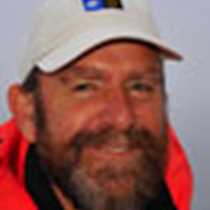Wilhemsøya and Bjørnsund, Svalbard
Late yesterday (for there is no night!) we reached our furthest north, at Brageneset, in Hinlopen Strait (79º42.02'N). The ship came to a full stop, thwarted by an implacable barrier of buckled plates, vertical white fangs and fractured sheets where the sea-ice had been tortured by pressure ridges. We gazed out across a ghostly frozen world, still and hushed, the only movement black guillemots paddling happily between the floes and strings of Brünnich’s guillemots flying steadily past us, still going north. A frozen Arctic tableau– unforgettable.
This morning at 0500, our bleary-eyed naturalists still scan the ice edge. Passing kittiwakes scan the ship similarly for signs of life: nothing save for the strange, hunched figures on the bridge-wing, welded to their telescopes. As the sun climbs above the fogbanks, these hunched shapes thaw enough to attempt the complex coordination of holding both binoculars and coffee-mug. By 0730 the smell of cooked breakfast proves too much and they slip, one by one, from the bridge. But the vigil continues as first mate and helmsman take up the ritual: scan, focus, scan, double-check, scan, focus. Now the sun is sparkling off a dark cobalt blue sea as we turn into the narrow channel of Bjørnsundet: Bear Sound. But there is no sound. Just gilded sea, brown crags and white glacier. A brief flurry of Arctic terns feeding in the currents of the sound. A lone reindeer silhouetted on the dolerite ridge above the fast ice. There are distant black maggots on the white ice; ringed seals. Surely then, there must be bears here? The sharpest eyes on the bridge scan, then halt. Focus the telescope. Yes! Tom Smith has found us the bear of the day: out in the shimmering white plain the lone cream figure of a solitary polar bear, working the white wastes for a careless seal. We rest with our stem on the pack-ice, the blue shadow of the crow’s nest staining the ice where our lookout still scans for the aid of those on the prow.
In the afternoon, the sun is warm on our backs. But the men on the bridge wing stiffen suddenly: two brown lumps on a distant icefloe look different. As we approach under minimum power, we are sure: a walrus cow and an adolescent calf. Already it is a prodigious size: perhaps 800lb, but a mere stripling next to the cow, who is a sprawling, mountainous ton of muscle and blubber. We creep up, observe quietly and creep away without disturbing them. This is how we should leave the Arctic: intact and unaltered. We are the ones who will never be the same, our heads full of vivid images. It is 2200 as I write, the ship searching the ice to the south. The hunched figures are still there, keeping their lonely vigil on the bridge wing, still scanning sea and ice for signs of life.
Late yesterday (for there is no night!) we reached our furthest north, at Brageneset, in Hinlopen Strait (79º42.02'N). The ship came to a full stop, thwarted by an implacable barrier of buckled plates, vertical white fangs and fractured sheets where the sea-ice had been tortured by pressure ridges. We gazed out across a ghostly frozen world, still and hushed, the only movement black guillemots paddling happily between the floes and strings of Brünnich’s guillemots flying steadily past us, still going north. A frozen Arctic tableau– unforgettable.
This morning at 0500, our bleary-eyed naturalists still scan the ice edge. Passing kittiwakes scan the ship similarly for signs of life: nothing save for the strange, hunched figures on the bridge-wing, welded to their telescopes. As the sun climbs above the fogbanks, these hunched shapes thaw enough to attempt the complex coordination of holding both binoculars and coffee-mug. By 0730 the smell of cooked breakfast proves too much and they slip, one by one, from the bridge. But the vigil continues as first mate and helmsman take up the ritual: scan, focus, scan, double-check, scan, focus. Now the sun is sparkling off a dark cobalt blue sea as we turn into the narrow channel of Bjørnsundet: Bear Sound. But there is no sound. Just gilded sea, brown crags and white glacier. A brief flurry of Arctic terns feeding in the currents of the sound. A lone reindeer silhouetted on the dolerite ridge above the fast ice. There are distant black maggots on the white ice; ringed seals. Surely then, there must be bears here? The sharpest eyes on the bridge scan, then halt. Focus the telescope. Yes! Tom Smith has found us the bear of the day: out in the shimmering white plain the lone cream figure of a solitary polar bear, working the white wastes for a careless seal. We rest with our stem on the pack-ice, the blue shadow of the crow’s nest staining the ice where our lookout still scans for the aid of those on the prow.
In the afternoon, the sun is warm on our backs. But the men on the bridge wing stiffen suddenly: two brown lumps on a distant icefloe look different. As we approach under minimum power, we are sure: a walrus cow and an adolescent calf. Already it is a prodigious size: perhaps 800lb, but a mere stripling next to the cow, who is a sprawling, mountainous ton of muscle and blubber. We creep up, observe quietly and creep away without disturbing them. This is how we should leave the Arctic: intact and unaltered. We are the ones who will never be the same, our heads full of vivid images. It is 2200 as I write, the ship searching the ice to the south. The hunched figures are still there, keeping their lonely vigil on the bridge wing, still scanning sea and ice for signs of life.




